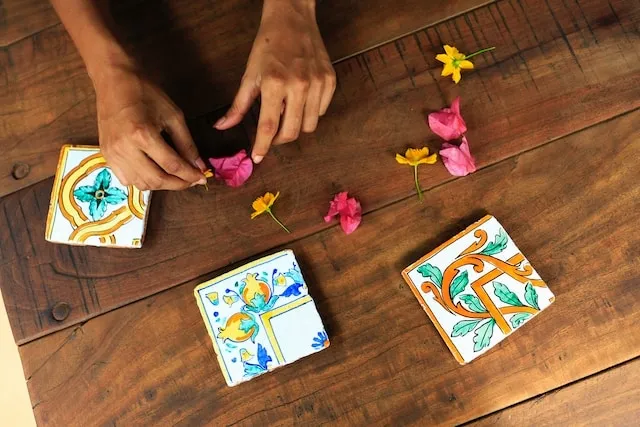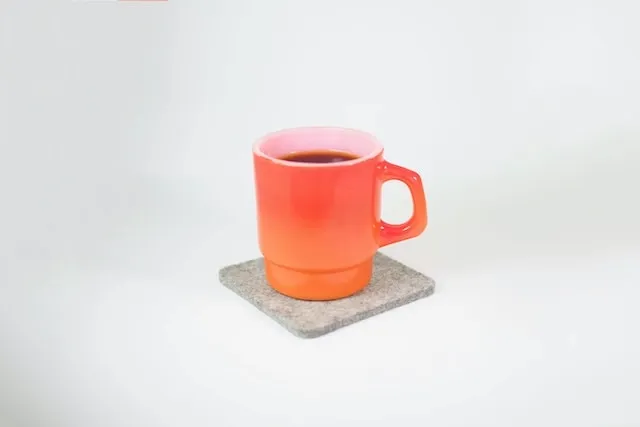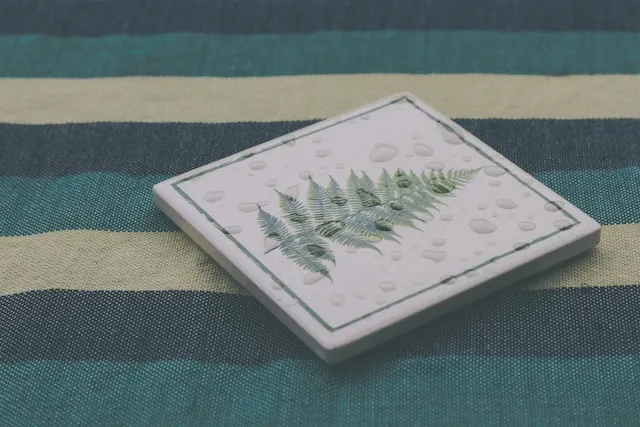What To Put On The Bottom Of Homemade Coasters
When you craft homemade coasters, the main focus is usually the design on the top. But the coaster bottom material is another crucial element that affects the way your DIY creations work in practical applications. For certain coaster materials, protective padding underneath can help prevent scratches on tabletops. The underside material can also help avoid sliding, making your coasters more user-friendly. They make little difference to the coaster aesthetic, but can significantly impact their practicality as tabletop protectors.
In this post, we will look at some materials you could use and explore alternatives to making coasters at home.

Key Takeaways
- There are many options for coaster bottom materials, including rubber, silicone, cork and felt.
- The best material is the one that delivers the benefits you need most.
- It may not be necessary to add a backing material to all custom coaster types.
- Benefits of adding a backing to DIY coasters include slip and scratch prevention.
- It is straightforward to apply a coaster bottom material to a coaster once you have chosen the material you want.
What To Put On The Bottom Of Coasters
There are various materials to consider for what to put on the bottom of coasters, each offering its unique properties to enhance surface protection. Rubber and silicone provide excellent grip and scratch prevention, while cork offers a gentler touch for your tabletops. Regardless of your design ideas for DIY coasters, it's essential always to consider how your chosen material will interact with the surface beneath.

Rubber Bottoms For Coasters
Rubber is a highly durable material that you can affix to the bottom of coasters made from materials such as:
- Wood
- Ceramic
- Plastic
- Fabric
Its inherent non-slip properties make it an excellent choice as a coaster bottom material, ensuring your coasters stay securely in place on smooth surfaces. Rubber is also effective at preventing scratches, thanks to its soft and cushioning characteristics when in contact with tabletops. Moreover, it is very easy to clean; a simple wipe should suffice.
The downside of using rubber for your DIY coasters is that it tends to be slightly more expensive than some simpler materials. Additionally, it adds thickness to the coaster, and there is the occasional potential for it to stick to surfaces.
Adhesive Bottoms For Coasters
For coasters intended for semi-permanent placement, an adhesive bottom can be a suitable choice. They offer a robust and secure attachment option and can be affixed to a wide range of coaster materials. Their slim profile helps maintain a sleek and minimalist appearance, and you have the flexibility to customize the size and shape of the adhesive backing to match your DIY coaster's requirements.
However, for most purposes, adhesive backing is not recommended as a coaster bottom material. This is primarily because of its limited reusability, as the adhesive backing tends to lose its adhesiveness after removal. This becomes particularly problematic for coaster materials that require regular cleaning, such as cork. Furthermore, adhesive bottoms may not be compatible with certain coaster or table materials, and they are prone to leaving residue on surfaces.
Cork Coaster Bottom Material
In the question of what to use for the bottom of coasters, cork is a common choice. It's an absorbent material that effectively soaks up moisture, preventing spills from reaching your tabletop. Additionally, cork boasts a natural and rustic aesthetic that complements various other materials. It provides a gentle touch on your surfaces and offers natural non-slip properties, reducing the risk of your coasters sliding on smooth tabletops. It is also known to be a sustainable material.
However, there are some cons to consider when using cork as a coaster bottom material:
- Cork requires regular maintenance, including cleaning and drying, to keep it in optimal condition.
- Excessive moisture buildup can lead to the breakdown of the cork material over time.
It's worth noting that we utilize a cork backing for the underside of our ceramic coasters. If you're looking for high-quality, personalized coasters without the effort of making them yourself, you can take advantage of our service. We offer outstanding craftsmanship to bring your designs to life, and our ceramic coasters come with a cork backing for added functionality and appeal.
Silicone Bottoms
Much like rubber, silicone stands as a strong contender for your coaster bottom material. Silicone boasts durability and minimal maintenance requirements, unaffected by exposure to water. Its soft and gentle nature excels in scratch prevention while providing exceptional grip on the underlying surface, ensuring your coaster remains securely in place on any tabletop.
However, similar to rubber, there are certain downsides to consider. The thickness of silicone, while beneficial for cushioning, may result in a bulkier appearance for your coasters. Additionally, it has a propensity to stick, particularly in moist conditions. Furthermore, it tends to be a more expensive choice compared to cork or adhesive backing options. Consider these factors carefully when brainstorming ideas for your own custom DIY coaster project.
Felt Bottoms
Many coasters made from ceramic, stone, metal, and plastic come with a felt bottom. Felt is a soft and cost-effective material that offers protection against scratches and scuffs on your surfaces. Its elegant appearance is appealing to many, and it also reduces noise when coasters are moved, cushioning impacts and minimizing scrapes. Additionally, it possesses basic non-slip properties to prevent coasters from sliding on smooth tabletops.
However, despite its affordability, felt has the downside of being less durable than some alternative materials. It requires regular cleaning and should be kept dry to avoid fabric breakdown and potential mildew growth. With proper maintenance, though, felt remains an excellent option for coaster bottoms.
In fact, we hold such an affinity for felt that we actually create custom felt coasters as part of our range. With numerous personalization options available, you can fully harness the advantages of felt as a coaster material in its own right, rather than merely as a backing material.
Bumper Pads
Bumper pads are typically made from rubber, silicone, or felt, although they can be crafted from other materials as well. They serve as a cost-effective choice for coaster bottom materials, offering non-slip properties and effectively safeguarding your surfaces against scratches. These pads are straightforward to apply, often equipped with self-adhesive features, and they maintain a slim profile, ensuring minimal added thickness to your coasters.
The cons of bumper pads include the following:
- Poor durability: The adhesive that holds bumper pads in place can wear down quite quickly, and the pads themselves will likely need to be replaced due to wear and tear.
- Moisture sensitivity: If moisture gets under your coasters, it is likely to compromise the adhesive that sticks the bumper pads to your coasters.
- Residue: When you take the adhesive bumper pads off your coaster, they will likely leave an adhesive residue that is difficult to clean off.
If you want an inexpensive solution for what to put on the bottom of coasters, bumper pads are a good option. But their downsides must be considered for the long-term use of your coasters.

Which Material Is Best To Put On Coasters Bottom?
When considering the best choice for what to put on the bottom of coasters, there is no single answer. It comes down to what material your coasters are made from, and what you want to get from your coaster bottom material.
Let’s take a look at some different priorities and the best solution to meet your needs:
- Best all-round material: If cost is not concern, the best all-round material would be rubber, silicone or cork. All are relatively easy to apply to your custom coasters, and offer excellent properties for protecting tabletops and preventing slipping in use.
- Best budget option: If you want to spend as little money as possible on your coaster bottom material, bumper pads are probably the best choice. Felt is another great option, so it really depends on which works best for your needs.
- Best for non-slip: Rubber and silicone are the solutions for what to put on the bottom of coasters to prevent slipping. Cork, felt and bumper pads also offer reasonable non-slip characteristics, and an adhesive backing completely prevents movement if you don’t mind dealing with its downsides.
- Best for scratch prevention: Cork and felt are the best materials for preventing scratches. They are soft and provide a gentle touch for surfaces, even if coasters are made from heavy materials like stone or ceramic.
As you can see, there are different coaster bottom materials that are best suited to different purposes. When considering your options, think about what your coaster is for and which properties will be most useful for you.
Want customized coasters that don’t need a protective bottom?
When you order custom cork coasters, the cork base is gentle on your tabletop so you don’t need to add a bottom. And you can customize the top design.
Do You Really Need To Buy Materials For Coasters Bottom?
When exploring the various material options available in our custom coaster service, you'll notice that most of them do not include a separate backing material. In fact, we manufacture coasters using some of these materials themselves. If you desire the inherent properties of these materials, you can work with us to design your own coasters crafted from:
- Rubber
- Felt
- Cork
It's worth noting that our ceramic coasters feature a cork backing, while the other materials do not require a separate backing. This is primarily because high-quality products like ours inherently minimize the risk of scratching surfaces or coaster slippage. By designing your personalized coasters with your preferred material, you can enjoy premium, affordably-priced products that not only enhance your decor but also safeguard your tables without the added complexity of a backing material.
When you're learning how to make your own tea coasters, you may come across guides that emphasize the importance of adding a backing material. While there are advantages to doing so, particularly for DIY coasters, it's important to understand that it isn't absolutely necessary in all cases.
What Are The Benefits Of Having Homemade Coasters With Good Material Bottoms?
While we maintain that they are not an absolute necessity, there can be benefits to adding the right coaster bottom material to your DIY coasters. Whether you choose one of the options listed in this post or something else, here are some advantages you will experience from incorporating a suitable backing material on the underside of your coasters:
- Preventing scratches: Some heavier or more abrasive coaster materials like slate, stone or ceramic can cause scratches and scuffs on more delicate tabletop materials.
- Avoiding slipping: If you craft your own coasters from materials like wood or plastic, there could be a risk that they slide easily on smooth surfaces like tabletops.
- Noise reduction: backing materials with a gentle touch, like felt or cork, can help reduce the noise it makes when coasters are placed or moved on a surface.
- Moisture absorption: If you choose an absorbent coaster bottom material like cork, it can add an extra dimension of protection against drips and spills for your tabletops.
There are, undoubtedly, reasons to consider what to put on the bottom of coasters when making your own DIY custom coaster projects. But if you order high-quality personalized coasters from a respectable vendor like us, it is not necessary to add another material to the design.

Choose a protective coaster material and add a soft bottom
Our custom ceramic toasters look chic and sophisticated, and you can add a cork or felt bottom to ensure they are gentle on surfaces whilst shielding against moisture.
Learn moreHow To Change The Bottom Of Your Coaster In An Easy Way
If you want to modify an existing coaster by removing its backing material and replacing it with a new one, the solution is fairly simple. You will need to gather the coasters and have the new material to hand, cut to the right size and shape and ready to apply. You will then need to use a utility knife to remove the existing backing so that you can apply the new one.
Here is the process:
- Cut off the existing backing, removing as much residue as possible.
- Apply adhesive if your new material doesn’t have self-adhesive properties.
- Attach the new backing material, using a weight to hold it firmly in place as the adhesive sets.
- Trim any excess if necessary for a neat fit.
If you are dealing with DIY custom-made coasters, there won’t be an existing backing to remove. In this case, you can simply apply the new backing. If you would prefer not to do any of this, you can design your own personalized coasters on our website and order them in any quantity you need to get high-quality, cost-effective custom coasters.
Frequently Asked Questions About What To Put On The Bottom Of Coasters
What To Put On The Bottom Of Coasters
There are many options for this, including rubber, silicone, cork, felt and bumper pads. There are pros and cons to each, but they can offer additional tabletop protection.
Which Material Is Best To Put On Coasters Bottom?
This depends on your needs. Rubber and silicone have excellent non-slip properties, while cork and felt are superb for scratch prevention.